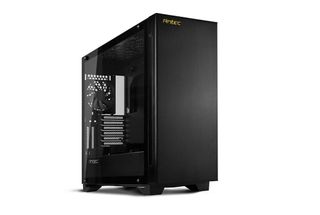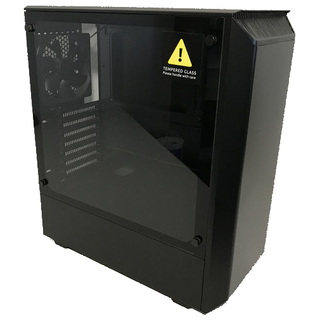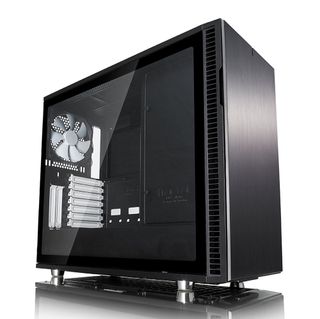Riotoro CR500 Tempered Glass Mid-Tower Case Review
Why you can trust Tom's Hardware
Benchmark Results & Conclusion
For comparison purposes, we chose to pit the Riotoro CR500 against the Antec P110 Luce, the Phanteks Eclipse P300, and the Fractal Design Define R6 TG, because they are of similar size and features, and all have tempered-glass side panels.
Riotoro’s decision to equip the CR500 with two 120mm intake fans and a single 120mm exhaust fan proved to be a wise design choice. This combination made quick work of the heat generated by our test system. Fan speeds were manually set at 1,400 RPM for testing. CPU core temperatures on our budget quad-core i5-7500 processor running at 3.8GHz maxed out at 44°C over ambient temperature (25°C) during testing. Graphics card temperatures remained steady at 52°C over ambient temperature.
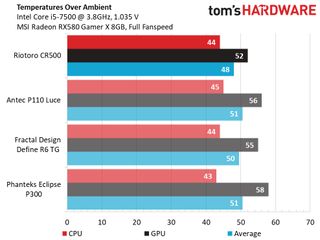
We were pleasantly surprised by the acoustic performance of the CR500. This is given the fact that, of the cases used for comparison purposes, it was the only chassis that features a mesh front panel, so we were expecting higher noise levels. It would seem that the filter material behind the mesh front panel did a pretty good job keeping fan noise down.
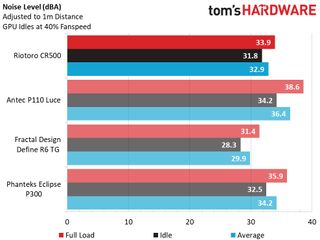
Cooling efficiency and noise levels are both ways to measure performance. Determining acoustic efficiency, also referred to as "cooling-to-noise ratio," is a matter of averaging all five of our tests to determine a base value.
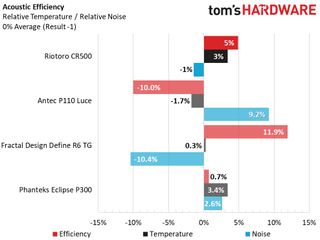
Looking at our value chart, the Riotoro CR500 is dead even with both the Phanteks Eclipse P300 and the Fractal Design Define R6 in terms of basic features and price. This chassis, even with features taken into account, is a much better value than the Antec P110 Luce. Given this chassis’ solid thermal performance and respectable noise levels, the asking price of $60 seems like a bargain to us.
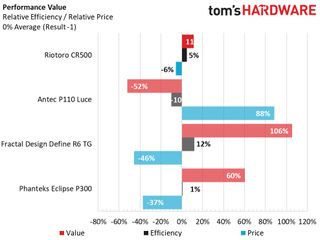
The Riotoro CR500 checks all the right boxes. The chassis sports a tempered-glass side panel, good acoustic and thermal performance, and three 120mm fans, two of which feature red LED lighting. Overall, this is a great chassis for the money.
MORE: Best Cases
MORE: All Case Content
Current page: Benchmark Results & Conclusion
Prev Page Hardware Installation & Test ConfigurationStay on the Cutting Edge
Join the experts who read Tom's Hardware for the inside track on enthusiast PC tech news — and have for over 25 years. We'll send breaking news and in-depth reviews of CPUs, GPUs, AI, maker hardware and more straight to your inbox.
-
berezini.2013 if you look closely the bottom dust filers leave a huge gap between the case and the filter due to the "clips" being on an embossed plane. You say that they are effective, what proof do you have to make such claims? i don't see you using the case in real world situations and testing how dust is propelled and testing where dust settles and where it seeps into the case from. This whole thing is a bunch of advertisement and wild accusations.Reply -
BaRoMeTrIc Reply20720083 said:if you look closely the bottom dust filers leave a huge gap between the case and the filter due to the "clips" being on an embossed plane. You say that they are effective, what proof do you have to make such claims? i don't see you using the case in real world situations and testing how dust is propelled and testing where dust settles and where it seeps into the case from. This whole thing is a bunch of advertisement and wild accusations.
Air takes the path of least resistance so the majority of the dust will be collected in the filter. but just like any hing dust will still make it's way through. I have a silverstone mammoth case for my server chassis and it still collects dust, albeit very minute. -
stevenlynch Hi, BEREZINI.2013Reply
What we actually said is the filtration system is "...is basic but effective. The two removable filters on the bottom of the case will keep larger dust particles out of your system." We do flow testing on each chassis and we actually DO test in real world situations. As always, we appreciate your time, opinion and feedback.
